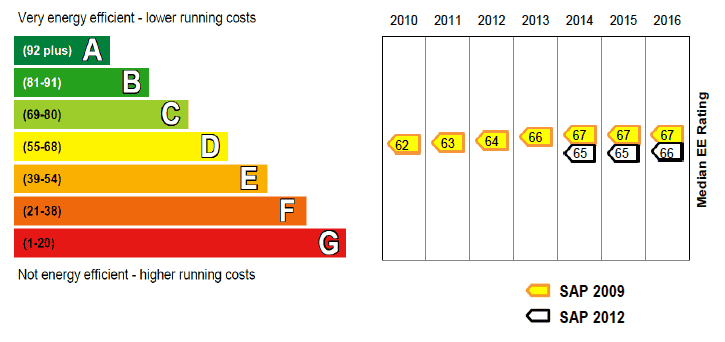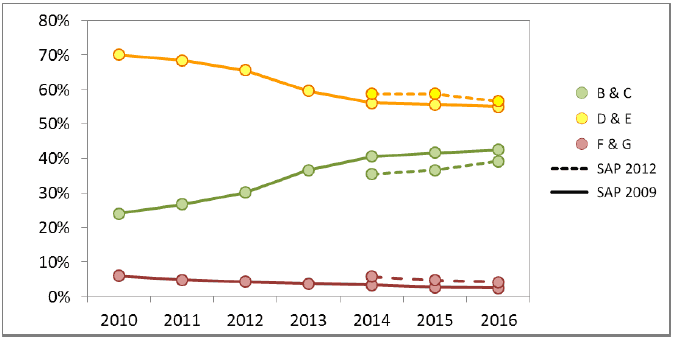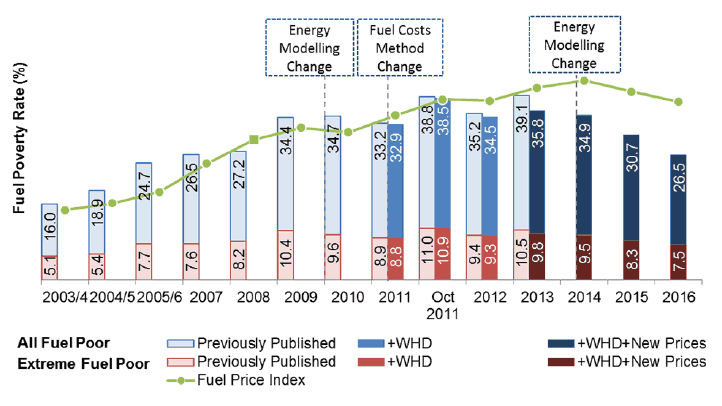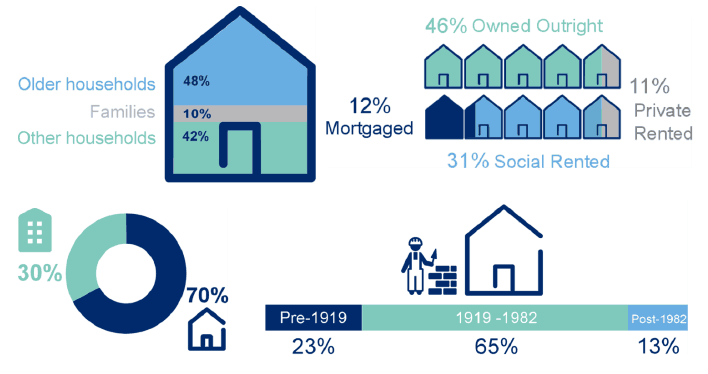Scottish house condition survey 2016: key findings
2016 survey findings including fuel poverty rates, energy efficiency ratings, carbon emissions, Scottish Housing Quality Standard and disrepair.
This document is part of a collection
Key Findings Summary
Energy Efficiency and Carbon Emissions
- In 2016, 39% of Scottish homes were rated as EPC band C or better and half had an energy efficiency rating of 66 or higher ( SAP 2012). This is similar to 2015 but an increase from 35% in 2014, the first year in which data based on SAP 2012 is available.
- In the last year, the share of older properties (1919-1944) and properties built between 1965 and 1982 in band C or better increased by 8 percentage points to 31% and 37% respectively.
Median Energy Efficiency Rating Relative to
EPC Band,
SAP 2009
and
SAP
2012

- Using SAP 2009 continues to show improvement in the energy efficiency profile of housing. The share of the most energy efficient dwellings (rated C or better) increased from 24% in 2010 to 43% in 2016. In the same period, the proportion of properties in the lowest EPC bands (E, F or G) has almost halved, reducing from 27% to 14%.
Proportion of Scottish Homes by Grouped
EPC Band,
SAP 2009
and
SAP
2012

- The share of homes with lofts insulated to 100 mm or more was 94% in 2016 which is similar to 2015. This represents an increase of 12 percentage points on 2010 levels. 30% of lofts were insulated to a high standard of insulation (300 mm or more), a similar level to 2015 following significant increases from 5% in 2010.
- Levels of wall insulation remained similar in the last year, with 58% of walls having insulation in 2016. 15% of solid wall dwellings and 72% of cavity wall dwellings were insulated in 2016. Wall insulation measures continue to be delivered under energy efficiency programmes such as ECO and the SHCS data suggests that this is having an impact on the share of dwellings with wall insulation although sample size limitations mean that the difference since 2015 is not statistically significant. The data demonstrates a long-term trend of improvement in the insulation of cavity walls with the proportion increasing by 6 percentage points since 2012.
- In 2016, 52% of gas and oil boilers meet the minimum efficiencies specified by current Building Standards, an increase of 5 percentage points from 2015.
- 29% of dwellings had an environmental impact rating in band C or better in 2016 ( SAP 2012). The mean rating was 59 which lies in band D.
- Based on modelled energy use the average Scottish home is estimated to produce 7.0 tonnes of CO 2 per year. Average modelled carbon emissions for all properties have decreased in the last year from 78 kg per square meter of floor area to 76 kg/m 2.
Fuel Poverty and Heating Satisfaction
- In 2016 fuel poverty declined by about 4 percentage points, equivalent to around 99,000 fewer households living in fuel poverty compared to 2015. 26.5% (or around 649,000) households were fuel poor and 7.5% (or 183,000 households) were living in extreme fuel poverty in 2016. This is the second consecutive annual decrease and the lowest rate recorded by the survey since 2005/06.
Proportion of Households in Fuel Poverty and Extreme Fuel
Poverty, 2003/4-2016

- Almost two thirds (2.7 percentage points) of the reduction in fuel poverty rates between 2015 and 2016 can be attributed to the drop in the price of domestic fuels over this period. Around a third (1.5 points) can be attributed to improvements in the energy efficiency performance of the housing stock and the rest (0.1 points) can be explained by higher household incomes.
- Between 2015 and 2016 there has been a more noticeable decline in fuel poverty in the private sector, increasing the gap when compared to the social sector. Fuel poverty rates in the private sector have reduced from 30% to 25% while the rate in the social sector was similar to the previous year at 32% in 2016.
- Less than a quarter (23%) of households using gas as the primary heating fuel are fuel poor, down from 27% in 2015. This is likely to be at least in part due to the fall in gas prices accelerating compared to the previous year.
- Similarly, urban households have gained disproportionately in the last year with fuel poverty levels falling 6 points to 24%. Rural fuel poverty rates have remained similar to 2015 levels at 37% in 2016.
Composition of Fuel Poor Households, 2016

- Around 10% of fuel poor households are families with children, the rest being almost equally split between older households (48%) and other households without children (42%). Almost 6 out of 10 (58%) are owner occupiers and over two-thirds live in houses (70%).
- Almost half (47%) of fuel poor households have incomes above the poverty threshold, defined as £291 per week before housing costs for a couple without children. Fuel poverty rates have declined for households living above the income poverty threshold, from 20% in 2015 to 15% in 2016. The rate for households below the income poverty threshold has remained similar to 2015 levels at 78%.
- Fuel poor households are more likely to report difficulties staying warm in winter. 23% of them say that their heating keeps them warm in winter "only sometimes" (16%) or "never" (7%) compared to 16% of all other households. This pattern is similar to 2015 although the overall levels are lower. 6% of fuel poor households report that they cannot afford to heat their home.
- Overall, in the past year, there have been improvement in the share of householders reporting that their heating only sometimes (14%) or never (4%) keeps them warm in winter. This is a reduction of 5 percentage points from 2015 and the lowest level recorded by the survey since 2007.
- The extent to which home energy use is monitored by householders remains unchanged since last year with 56% stating they monitor their energy use "very" or "fairly closely". However there has been an increase of 2 percentage points, to 10%, in households reporting that they own an energy monitoring device. Fuel poor households are no more likely to monitor their energy use than other households but they are less likely to own a monitoring device (6% compared to 11% for non-fuel poor households).
Housing Quality
- The level of disrepair reduced by 5 percentage points in the last year. In 2016, 68% of all dwellings had some degree of disrepair, however minor it may be, down from 73% in 2015. Disrepair to critical elements stood at 48% while 28% of dwellings had some instances of urgent disrepair and 6% had some extensive disrepair.
- Levels of damp and condensation remained similar to 2015. Around 9 out of 10 (89%) properties were free from any damp or condensation.
- Compliance with the tolerable standard in 2016 also remained similar to 2015: 2% (or 39,000) of all dwellings fell below the tolerable standard. This represents an improvement of 2 percentage points since 2012.
- Across the stock as a whole, Scottish Housing Quality Standard ( SHQS) compliance remained at 2015 levels. In 2016, 45% of Scottish homes failed to meet the SHQS.
- The SHQS failure rate in the social sector was 38%, not allowing for abeyances and exemptions. This has fallen from 60% in 2010. 26% of properties did not meet the Energy Efficient criterion.
- SHCS surveyors may not always be able to identify the presence of cavity wall insulation. The overall SHQS failure rate in the social sector would be 26% if it is assumed that all social dwellings have insulated cavity walls where this is technically feasible.
- The majority of dwellings falling below the SHQS failed on a single criterion: this accounts for more than 8 out of 10 failures in the social sector. For 7 out of 10 social homes which failed the SHQS this was due to falling short on a single one of the standard's 55 elements.
- Overcrowding levels in Scotland remain unchanged: 3% of all households (67,000) were living in overcrowded accommodation in 2016.
Contact
There is a problem
Thanks for your feedback